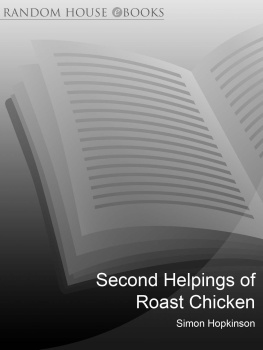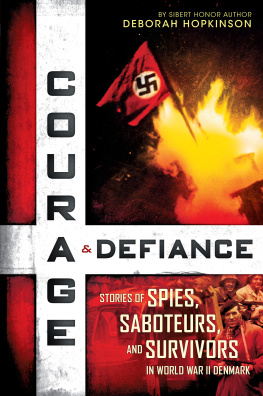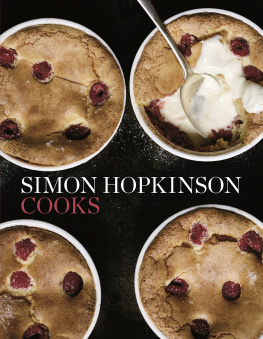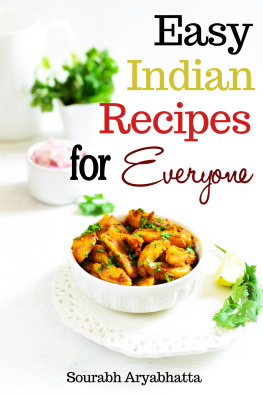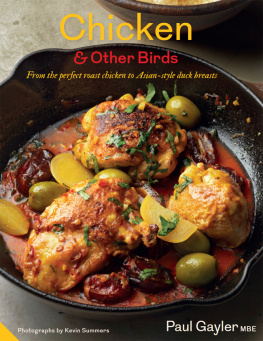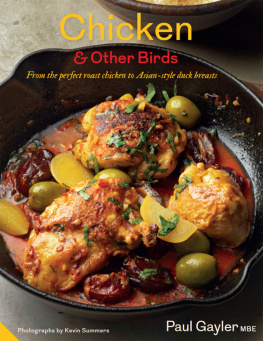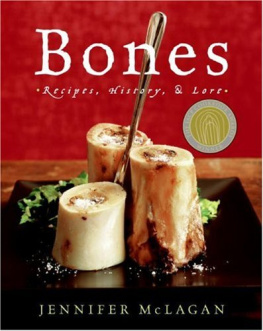C ONTENTS
Also by Simon Hopkinson
Roast Chicken and Other Stories
SECOND HELPINGS OF ROAST CHICKEN
A Recipe Book
By
Simon Hopkinson
Illustrations by Flo Bayley
This ebook is copyright material and must not be copied, reproduced, transferred, distributed, leased, licensed or publicly performed or used in any way except as specifically permitted in writing by the publishers, as allowed under the terms and conditions under which it was purchased or as strictly permitted by applicable copyright law. Any unauthorised distribution or use of this text may be a direct infringement of the authors and publishers rights and those responsible may be liable in law accordingly.
Epub ISBN: 9781446407547
Version 1.0
www.randomhouse.co.uk
3 5 7 9 10 8 6 4
Copyright Simon Hopkinson 2001
Illustrations copyright Flo Bayley 2001
Simon Hopkinson has asserted his right to be identified as the author of this work in accordance with the Copyright, Designs and Patents Act 1988.
All rights reserved. No part of this publication may be reproduced, stored in a retrieval system, or transmitted in any form or by any means, electronic, mechanical, photocopying, recording or otherwise without the prior permission of the copyright owner.
First published in 2001 by Macmillan.
This edition published in 2006 by Ebury Publishing,
Random House, 20 Vauxhall Bridge Road,
London SW1V 2SA
www.randomhouse.co.uk
Random House Australia (Pty) Limited
20 Alfred Street, Milsons Point, Sydney, New South Wales 2061, Australia
Random House New Zealand Limited
18 Poland Road, Glenfield, Auckland 10, New Zealand
Random House South Africa (Pty) Limited
Isle of Houghton, Corner of Boundary Road & Carse OGowrie,
Houghton 2198, South Africa
The Random House Group Limited Reg. No. 954009
A CIP catalogue record for this book is available from the British Library.
ISBN 9780091912321
For Ann and Franco Taruschio with love and gratitude
F OREWORD
Simon Hopkinson can be quite peremptory. Which is why we worry about things in our shopping baskets of which he wouldnt approve, or things we do over the stove which he would find sloppy, or things in our larders which are pre-packed or just packets. Why cant we all be as autocratic as Simon? Well, I can, so now Im giving you exact instructions on how to read this book:
1. First read the essay at the start of each section (forty-seven of these). Now you will understand why a very few cookery books should be read, and the rest just used. These exceptional books enhance your understanding of cooking and even of life. The rest just enhance a dish or a meal. Thank goodness for them, of course, but theyre reference, not reading. Simons predilections are not just good copy. They are well researched, brilliantly observed and compulsively readable.
2. Now turn back to the chapters you found most seductive and choose a recipe. The best are so mouth-watering that you will already be preheated to the point where your oil is almost smoking.
3. Just before you launch into one of these irresistible dishes, spare a thought for this little conundrum:
a) Simon always says you should not decide in advance what to cook. You should go to the market, see whats freshest and best, buy it and then decide what to do with it. And, of course, hes right if you live in Normandy, or Perigord, or Provence.
b) Simon gives you a recipe so compelling that youve simply got to do it for supper. So you rush out to buy the ingredients. OK, the tarragon is a bit tired and the spring onions arent exactly sparkling, but how else are you to do what Simon so commandingly says?
4. Forget the conundrum and get cooking. These are recipes that work. You will not just eat sumptuously, you will also learn how suddenly pears go off, how tarragon is indispensable, how rice needs real understanding, how suet is not to be disregarded, how mussels are more than marinires, and how peas and pears in tins are not to be sneezed at. Since I am invoked in the cocktail chapter I had better be tactful, but you ought to know that I have moved on to the Cajun Martini, gin wickedly marinated in jalapeo peppers.
You will also find a threnody running through this book, for good things neglected, forgotten, or undervalued. For the woodcock, for the vanished fish markets of our coastal towns, and for mums who once cooked from the land and not from the deep-freeze. Not a sad book, though. Actually rather a sparky one. Cook alongside Simon Hopkinson and life can never be glum for long. And hang on to your own culinary foibles, even if they seem a bit feeble in the face of Simons magisterial side-swipes at the world of trendy cooking.
Of course since Im writing this foreword, Ive had a privileged preview of this book. So I know that you who are standing in line for second helpings will enjoy your meal more than ever before. Me (although this is strictly not allowed), me, Im starting the queue for thirds.
March 2001
I NTRODUCTION
It took me a very long time to write the first Roast Chicken and Other Stories (published by Ebury Press in 1994). Around about five years, in fact, all told. In those days I wrote every single word with a nice and soft 2B pencil and used a yellow American lawyers pad on which to scribble them simply because I liked the colour and smoothness of the papers surface. Apart from anything else, I had always enjoyed writing in the calligraphic sense, that is and had acquired a particular skill in this respect at an early age. This quietly pleasurable talent has now deteriorated somewhat, mainly due to many years of unnecessarily speed-handwriting the lunch and dinner menus for both Hilaire (the first London restaurant in which I cooked) and, later, Bibendum, and which I constantly think of as a most tragic loss to me.
And with this in mind, if you will permit me, I feel moved to fondly recall my reading and writing master at prep school in the early 1960s, Mr Hooton (an extremely tall man who had previously been employed by the Cambridge police force), who, although being mildly eccentric You, boy, make all speed to the Lord High Pen at Heffers and equip yourself with the finest Osmiroid! was possessed of the finest script and also introduced me to The Hobbit at eight years old, which he recited in different voices for each and every character, with his Smaug interpretation being particularly terrifying.
Personally, however, I will for ever remember him as K. V. Hooton, as that was how I referred to him in my first letter home:... and we had a reading and writing lesson with K. V. Hooton. For it was as Cave Hooton that his name first came to be used by my previously informed, roister-boistering school chums as he strode along the school corridor, inexorably making his way towards juvenile din and the open classroom door...

